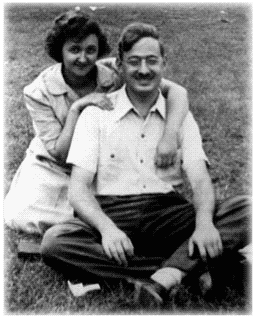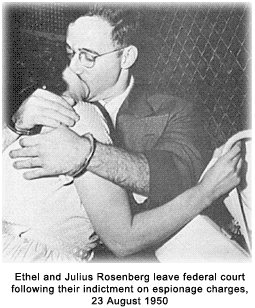In one of the most controversial capital punishment trials of the 20th century, a man and his wife were charged, tried, convicted, and executed, for the crime of “conspiracy to commit espionage against the United States,” at a time when the Cold War was just heating up.
 The avowed Communist Party couple also were accused of working with Soviet KGB agents to acquire nuclear weapons secrets, which smacked of treason. Although their co-defendants in the trial received sentences of 15 to 30 years in prison, the Rosenbergs became the first U.S. civilians to be executed for espionage.
The avowed Communist Party couple also were accused of working with Soviet KGB agents to acquire nuclear weapons secrets, which smacked of treason. Although their co-defendants in the trial received sentences of 15 to 30 years in prison, the Rosenbergs became the first U.S. civilians to be executed for espionage.
Unsurprisingly, media frenzy during the event heated public emotions to a white-hot intensity. While of America learned about the case through newspapers, a large audience followed it on radio and, to a lesser degree, on television.
Owing to the overheated political climate and frayed-nerve mindset of post-World War II America, a gulf widened between those who were convinced that a minimal amount of evidence was enough to convict the Rosenbergs, and those who believed the evidence was compromised, as presented by the prosecution.
Background
Julius was born in New York in May 1918, to Jewish parents. While working on his degree in electrical engineering at the College of New York, he joined the newly formed Young Communist League (YCL). There he met his future wife, Ethel Greenglass.
Born in September 1915, Ethel also was from a Jewish family. After attempts to become a singer or actress failed, she landed a job as a secretary for a shipping company. In an intrepid plunge — for a woman of those times — Greenglass got involved in labor disputes and joined the YCL.
After the two were married in 1939, Julius enlisted in the Army Signal Corps and specialized in radar equipment repair.
The KGB
In 1943, as World War II was being waged on numerous fronts, Semyon Semenov, a high-ranking officer of the KGB, recruited Julius Rosenberg, through his ties with the Communist Party USA, to provide classified information to the Soviets. Ostensibly, the Soviets needed the information because, as an ally with the U.S., they could fight the Germans on the Eastern Front with the advanced weaponry used by the U.S. in their battles.
Of particular interest to the KGB was the “proximity fuse.” When installed on air-to-ground, air-to-air, or ground-to-air missiles, the device could detonate a warhead without having to make a direct hit on the target. The fuse was based on the Doppler principle of the sudden dropping of frequency waves once past its target. That was a vast improvement over timing devices and other means of bomb detonation.
While the Rosenbergs, especially Julius, were possibly duped into thinking they were helping to bolster an ally, they were nonetheless complicit in acts against the U.S. in a time of war.
Co-conspirators and the Manhattan Project
When Semyonov was called back to Moscow in 1944, his duties were assumed by his protégé, Alexander Feklisov.
Feklisov cultivated a warm relationship with Julius, and eventually persuaded him to bring in his brother-in-law, David Greenglass — a machinist on the Manhattan Project — to supply the pipeline with information. Owing to the viewpoint that the U.S. should not possess the only atomic bomb, Julius managed to recruit Joel Barr, Al Sarrant, William Perl, and Morton Sobell.
Following the war, the U.S. was ultra-sensitive about sharing information with the U.S.S.R., so it came as a great surprise that the Soviets had managed to produce their own nuclear warhead. It was determined that German defector Klaus Fuchs, a theoretical physicist working for Great Britain, had passed secret documents to the Soviets via a courier.
Following his arrest, David Greenglass confessed to supplying documents to the KGB, then testified against his sister and Julius. Greenglass also named Sobell as an accomplice, but Sobell fled to Mexico City, seeking asylum. He was later extradited back to the U.S. for trial.
The trial and verdict
The trial predictably attracted media attention of a similar magnitude as the recent Alger Hiss affair. Some observers argued that media bias had influenced the verdict and/or the sentence imposed on the Rosenbergs.
During the trial, which began on March 6, 1951, the prosecution’s star witness, David Greenglass, continued to point the finger at his sister and Julius as conspirators who passed along sensitive information to the Soviets during wartime. Ethel was described by her brother as a “probationer” or “agent,” according to information provided by a sophisticated code-breaking device, known by its acronym VERONA. It was used by the U.S. intelligence corps to unravel foreign coded correspondence to and from Soviet operatives in the U.S., during and following the war.
She was found guilty of the charges, but many supporters felt that a capital charge of conspiracy was not only too harsh, but clearly was not supported by the evidence. They point to the fact that Ethel was never given a code name (Julius was “Antenna” or “Liberal”) making her role appear less significant than her husband’s.
The defining stroke of ignominy came down in 2001, when David Greenglass admitted that he had perjured himself regarding the testimony about his sister — nearly 50 years after her death — to protect his wife and children from persecution and possible prosecution.
As for Julius, he took the Fifth Amendment whenever questions about his connections to the Communist Party, or any of its members, were asked. That did not earn him any sympathy points with the jury.
 Evidence showed that indeed, he met with Feklisov more than 50 times during a three-year period. The quality of information, however, is somewhat suspect beyond that of the proximity fuse.
Evidence showed that indeed, he met with Feklisov more than 50 times during a three-year period. The quality of information, however, is somewhat suspect beyond that of the proximity fuse.
The trial ended on March 28, with the guilty verdicts read the following day. A week later, Judge Kaufman imposed the death penalty on the Rosenbergs; Sobell received a 30-year sentence.
Without being charged, Fuchs returned to England in 1946. However, he was arrested there in 1950, after intelligence officers gleaned enough information from the VERONA Project to confront him. Fuchs confessed, was found guilty and sentenced to 14 years in prison, the maximum in England for passing secrets to a “friendly nation.”
The execution
A series of appeals, including to the U.S. Supreme Court, ran out on July 19, 1953. The Rosenbergs were put to death in the electric chair. Julius died on the first surge of juice. But the chair was not a one-size-fits-all contraption — it was not designed for a petite female.
The grisly results were that, because of incomplete connections, three attempts had to be made on Ethel before death was pronounced. Some onlookers said that smoke could be seen rising from her scalp, with a foul odor wafting through the observation room.
Aftermath
The entire proceedings left many in tears, many more with a bad taste in their mouths, and a feeling that justice was far from served. An angry sentiment prevailed, and a grassroots crusade began, in part owing to the real fear of individual rights being usurped without the entire truth being heard by one’s peers.
Such maddening questions remain as:
Beyond the grave
The Rosenberg case refuses to go away. Their sons, orphaned at 10 and six, co-wrote a book, We Are Your Sons: The Legacy of Ethel and Julius Rosenberg (1975), about their experiences as orphans. Not one family member was willing to take them in, owing to fears of being fired by employers, or worse.
Documentaries, as well as fiction novels, have helped keep the case from collecting dust: